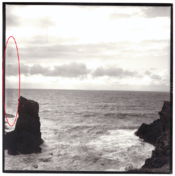Hello everyone
I've got some strange stains on a negative, and I'm not sure what they are.
They appear is some (not all) frames of a HP5+ 120 roll (I'm positive it's on the negative).
They are always on the same side, and only there.
My idea is that the film stuck to the spiral and developer or fixer couldn't properly get there.
The problem with this theory is that I checked and the spiral barely touches (if at all) the very edge of the frame.
Anybody else has an idea?
I used the Ilford Simplicity chemistry:
Ilfosol3 1+14 for 9:30 @ 22C
Ilfostop at recommeded dilution
Rapid fixer at recommended dilution
Final wash in distilled water
Dried in a film dryer at 30C if I remember correctly
Here is an example of the blotches, inside the red circle
I've got some strange stains on a negative, and I'm not sure what they are.
They appear is some (not all) frames of a HP5+ 120 roll (I'm positive it's on the negative).
They are always on the same side, and only there.
My idea is that the film stuck to the spiral and developer or fixer couldn't properly get there.
The problem with this theory is that I checked and the spiral barely touches (if at all) the very edge of the frame.
Anybody else has an idea?
I used the Ilford Simplicity chemistry:
Ilfosol3 1+14 for 9:30 @ 22C
Ilfostop at recommeded dilution
Rapid fixer at recommended dilution
Final wash in distilled water
Dried in a film dryer at 30C if I remember correctly
Here is an example of the blotches, inside the red circle











